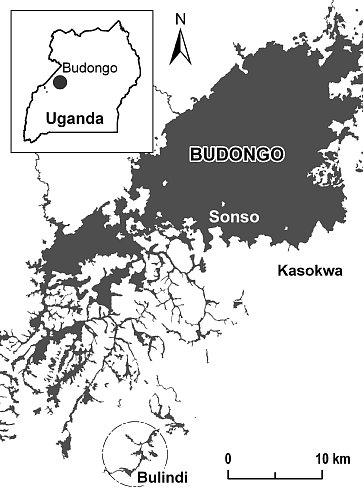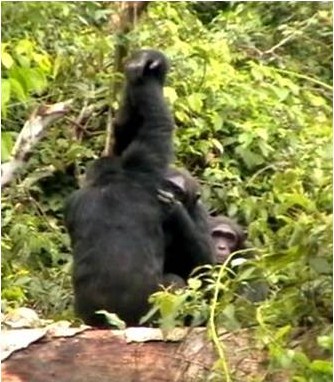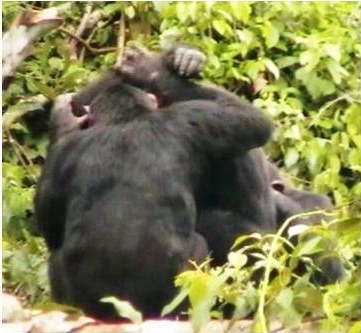|
<NOTE>
Preliminary Observations of Hand-Clasp Grooming by Chimpanzees at Bulindi, Uganda
Matthew R. McLennan
Anthropology Centre for Conservation, Environment & Development, Oxford Brookes University, UK INTRODUCTION The grooming hand-clasp (GHC) was the first documented social custom in wild chimpanzees1. It occurs when two chimpanzees seated opposite one another clasp hands overhead and groom each other’s underarm with their free hand. The resulting configuration is strikingly symmetrical. Variant forms include one participant grasping their partner’s hand or wrist, and ‘wrist-to-wrist’ in which participants rest their wrists against each other’s forearm, usually one partner supporting most of the weight of both2,3. The behavior may originate from branch-clasp grooming—a universal behavior in chimpanzees4—in which participants grasp an overhead branch whilst grooming socially1. GHC has a patchy distribution across Africa. It occurs in more study communities than not (whether present, habitual or customary), yet is notably absent at three long-term sites: Bossou (Guinea), Gombe (Tanzania), and Budongo (Uganda)4,5. Records from new study sites are valuable because they increase our understanding of chimpanzee behavioral variation. Here I report preliminary observations of GHC in chimpanzees at Bulindi, Uganda. STUDY SITE Bulindi is a forest–agriculture ecotone, 25-km south of Budongo Forest (Figure 1)6,7. I studied a community of &ge 25 chimpanzees for 18 months during 2006–2008. Although chimpanzees were unhabituated to close observation, from mid-2007 the community’s six adult males showed signs of semi-habituation7. Consequently, observations of social behavior including grooming and dominance interactions increased as the study progressed. 
Figure 1. Map showing the location of Bulindi (at bottom) in relation to Budongo Forest in western Uganda. Gray areas represent forest. The approximate home range of Bulindi chimpanzees is encircled. The locations of the Sonso community in Budongo and nearby Kasokwa community (where grooming hand-clasp has not been seen) are also indicated. An unknown number of small chimpanzee groups utilize forest patches to the north and west of Bulindi. OBSERVATIONS Two instances of GHC were observed in which the identity of participants was confirmed. At 0736 on 29 May 2007 we followed chimpanzee vocalizations to a clearing in heavily logged forest. Four adult males were seated on a rotting log, 27 m distant. Two males immediately climbed down behind the log while two (JL and MR) remained in view, staring with hair erect. Previous short-range encounters with chimpanzees generated alarm and agitation, usually accompanied by threats from adult males7. However, on this occasion the males did not threaten us. After approximately two minutes, JL and MR began self-grooming while monitoring us; a third male (JK) was peeping from behind the log. At 0808 KT climbed on the log and stood glaring at us with erect hair. When he sat JL began grooming him; after several minutes they groomed mutually. At 0818 they raised their right arms overhead and performed the wrist-to-wrist variant of GHC (Figure 2a). Video analysis indicated that JL initiated or facilitated the bout by momentarily taking hold of KT’s right forearm at elbow and wrist and gently pushing upwards (Figure 2b). Once extended, KT’s wrist appeared supported by JL’s wrist (Figure 2a). The bout lasted 49 seconds (Video 1, available online at mahale.main.jp/PAN/18_2/18(2)_03.html). 
Figure 2a. Adult males Julius (JL) and Keeta (KT) performing grooming hand-clasp (May 2007); behind them a young adult male Murray (MR) is watching observers. JL and KT were the topranked males at Bulindi. Although in this videostill KT (facing camera) appears to rest his wrist on JL’s wrist, possibly indicating his dominance (cf. reference2), ubsequent observations of social behavior suggested JL was alpha male (unpubl. data). 
Figure 2b. Video-still showing JL (with back to camera) apparently initiating grooming handclasp by momentarily holding KT’s forearm with both hands and gently pushing upwards. Video 1. Handclasp Grooming at Bulindi. Adult males JL (left) and KT (right) performing handclasp grooming at Bulindi (May 2007) The second instance occurred on 31 July 2007. At 0859 we observed JL, KT and MR in a Parkia filicoidea tree, 55 m distant. JL and KT were grooming mutually. At 0904 they raised their left arms and performed wrist-to-wrist GHC for approximately 60 seconds. On this occasion JL rested his left hand/wrist on KT’s forearm. Two further instances of GHC were recorded. On both occasions grooming chimpanzees were observed in tree crowns from &ge 80 m distance and identity of participants, and the form of GHC, was unconfirmed. In one case JL and KT formed a grooming clique with an estrous female but it was unclear if the two males performed GHC or if one performed it with the female. In the second case two adult males partially obscured by foliage performed GHC. Two other males in the party were identifiable (SL and MR). When the party moved off four adult males were present; the two unidentified males were almost certainly JL and KT. Overhead branch-clasp grooming was witnessed three times: once it occurred between JL and KT, once between KT and SL, and once between an unidentified adult male and estrous female. DISCUSSION GHC is performed usually, but not exclusively, by adults1,5,8. While a possible male bias was indicated in some studies2,9, adults of both sexes participate in this activity1,5. However, particular individuals9,10 and dyads5,10 may perform GHC more often than other group members. Adult females at Bulindi were shy of human observers and most grooming observations involved adult males. Thus, further study is needed to establish the occurrence of GHC in females at this site. Two well-observed GHC bouts involved the same two prime adult males (JL and KT) who were also the likely participants in two additional instances. These males performed GHC twice during four well-observed bouts of mutual grooming totalling 157 min. A third prime male (SL) groomed with KT during three bouts (118 min), but they did not perform GHC. JL and SL seldom interacted and were not seen grooming. Two young adult males (MR and JK) and an elderly male (LR) were also encountered regularly but were rarely seen grooming with other males. These preliminary observations suggest JL and KT—who both received submissive behavior from other males, including the largest male SL —had a GHC ‘partnership’10. More data are evidently needed, but we may tentatively classify GHC as ‘habitual’ at Bulindi4. While GHC occurs at Bulindi, it has not been seen 25 km north in the Sonso community at Budongo11. GHC has not previously been reported present in one community yet absent in another so nearby (Mahale, where it occurs, and Gombe, where it does not, are separated by 150 km; Kibale, where it occurs, and Sonso, where it does not, are 170 km apart). GHC has also not been seen in the small Kasokwa community bordering the southern edge of Budongo (Janette Wallis, pers. comm.) (see Figure 1). Bulindi chimpanzees use tools to excavate subterranean bee nests for honey—a behavior not recorded at Sonso or elsewhere in western Uganda12. The occurrence of GHC at Bulindi provides further evidence of behavioral variation among chimpanzees in the Budongo region. Multiple small chimpanzee groups inhabit forests patches within the cultivated landscape south of Budongo13. Chimpanzees occur north of Bulindi, closer to Budongo’s southern border (e.g. around Kasongoire Forest Reserve). Future studies should aim to establish the status of GHC among chimpanzees in this intervening area. GHC was first identified in 5/8 (63%) long-term study communities4. An expanded data-set reveals it occurs in 14/17 communities (82%), including two Pan paniscus communities5,8,14. If we include Bulindi and Kasokwa it occurs in 15/19 (79%). This suggests GHC is usually present in wild populations. Nevertheless, it is easier to confirm presence than absence in unhabituated or semi-habituated communities. Despite the emerging high prevalence of GHC in wild chimpanzees, the evidence for its absence at three sites (Bossou, Gombe, Sonso) is firm—Parkia it has not been seen at these sites in decades of fieldwork. GHC has emerged spontaneously in one captive colony15 and possibly one sanctuary-released group9. This indicates GHC is a dynamic social custom that potentially emerges and disappears in local populations repeatedly over time. ACKNOWLEDGEMENTS I thank the President’s Office, the Uganda National Council for Science and Technology, and Uganda Wildlife Authority for permission to work in Uganda. Dan Balemesa, Gerald Mayanda, Tom Sabiiti, Moses Ssemahunge and Jane Stokoe helped in the field. Research was funded by the ESRC and NERC, and the Leverhulme Trust (project reference: F/00 382/F). The manuscript was improved by comments from W.C. McGrew. REFERENCES
Back to Contents |